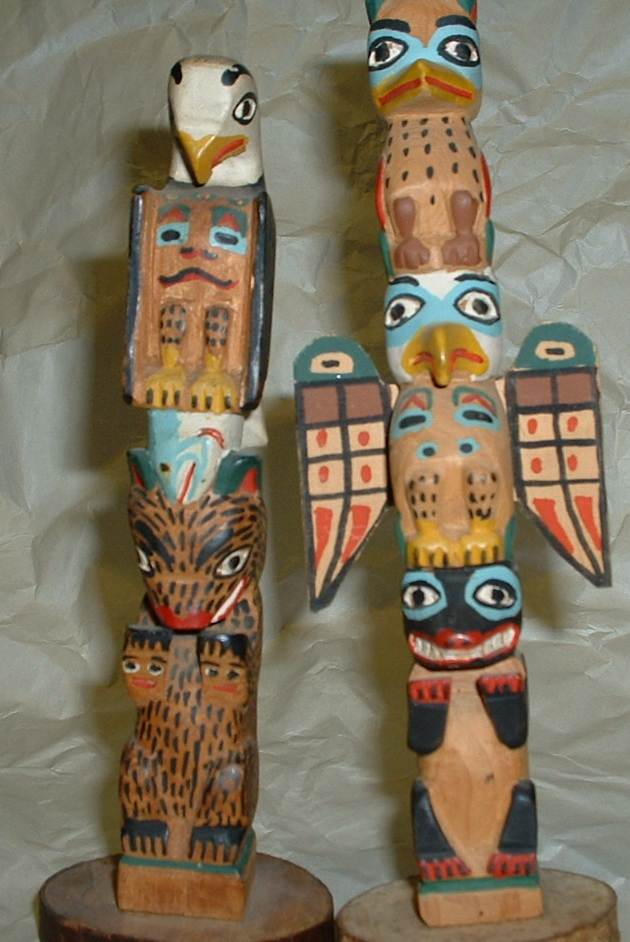There are some notable similarities between the Good Luck Totem and Chief Kian's Totem, including the interesting legend that good luck can be brought by rubbing the Kian pole's stomach. The examples below are signed models by Eli Tait, and a postcard view of the original totem. Certainly the carver or carvers of the original Kian pole (erected in Ketchikan around 1897) could be possible candidates for the inventor of the Good Luck Totem. The bottom wolf figure on the Tait's Kian pole displays some similarities to the bear on his Good Luck, notably in the coloring of the ears, the carving of the mouth, the upraised paws and general body contouring; but it is in the eagle, central on the Kian, that the similarities are most striking. In Tait's poles, and this is very consistent in almost all examples, we see all of the following on both the Kian and the Good Luck: on the chest-face, the eyes are blue ovoid-like shapes, with black pupils, surmouunted by green and red u-forms; legs have carved feet (yellow) and toenails (black), and nine black dots arranged in a 3x3 pattern. The nostrils are present, but the mouth is lacking on this Kian (this is the only Tait Kian I have available). However, the overall similarity of the two birds is quite apparent. The quizzical expression on the chest is one of the more consistent features of the good luck totems of Tait and Boyd. It is even more clear on the original pole, where the quizzical mouth is fully present, and additional black outlines around the eye-ovoids, as seen on at least one Tait pole (the sad one). It is also apparent that on the original the chest-face represents a particular crest figure, appropriate to Chief Kian or possibly to the carver, perhaps a whale, with the U-forms above the eyes intended to suggest fins or some other specific feature. Once having seen that quirky mouth on the original Kian, it is hard to avoid thinking that this is the source of some of the features found on the Good Luck totems carved by Tait and other Metlakatla carvers. It is also likely that the mosquito or crane sometimes seen on versions of the good luck pole is a direct reference to the crane or mosquito on the Kian pole. |
Chief Kian's totem and the Good Luck Totem Compared |
There are some notable similarities between the Good Luck Totem and Chief Kian's Totem, including the interesting legend that good luck can be brought by rubbing the Kian pole's stomach. The examples below are signed models by Eli Tait, and a postcard view of the original totem. Certainly the carver or carvers of the original Kian pole (erected in Ketchikan around 1897) could be possible candidates for the inventor of the Good Luck Totem. The bottom wolf figure on the Tait's Kian pole displays some similarities to the bear on his Good Luck, notably in the coloring of the ears, the carving of the mouth, the upraised paws and general body contouring; but it is in the eagle, central on the Kian, that the similarities are most striking. In Tait's poles, and this is very consistent in almost all examples, we see all of the following on both the Kian and the Good Luck: on the chest-face, the eyes are blue ovoid-like shapes, with black pupils, surmouunted by green and red u-forms; legs have carved feet (yellow) and toenails (black), and nine black dots arranged in a 3x3 pattern. The nostrils are present, but the mouth is lacking on this Kian (this is the only Tait Kian I have available). However, the overall similarity of the two birds is quite apparent. The quizzical expression on the chest is one of the more consistent features of the good luck totems of Tait and Boyd. It is even more clear on the original pole, where the quizzical mouth is fully present, and additional black outlines around the eye-ovoids, as seen on at least one Tait pole (the sad one). It is also apparent that on the original the chest-face represents a particular crest figure, appropriate to Chief Kian or possibly to the carver, perhaps a whale, with the U-forms above the eyes intended to suggest fins or some other specific feature. Once having seen that quirky mouth on the original Kian, it is hard to avoid thinking that this is the source of some of the features found on the Good Luck totems carved by Tait and other Metlakatla carvers. It is also likely that the mosquito or crane sometimes seen on versions of the good luck pole is a direct reference to the crane or mosquito on the Kian pole. |




Tait Good Luck and Kian totems |
Clyde Boyd totem, with added face, possibly a reference to Chief Johnson's pole. There is a photo from Klukwan, c. 1890, that shows a very similar fish, perhaps used as a dance paddle or puppet, and I suspect that is the secret of the fish: someone, probably Sydney Campbell, saw it in Klukwan, and incorporated it into the good luck design. |